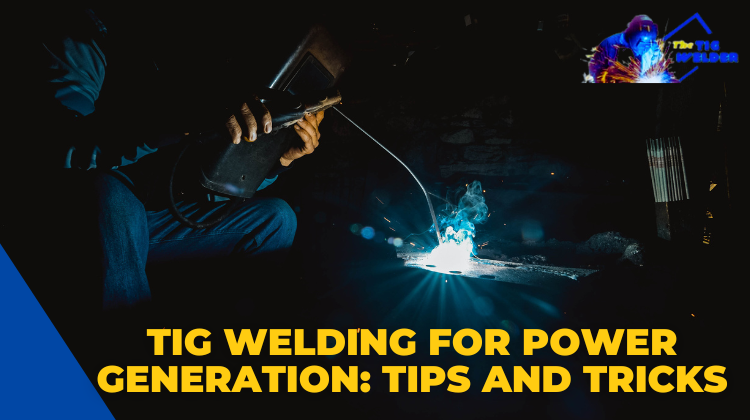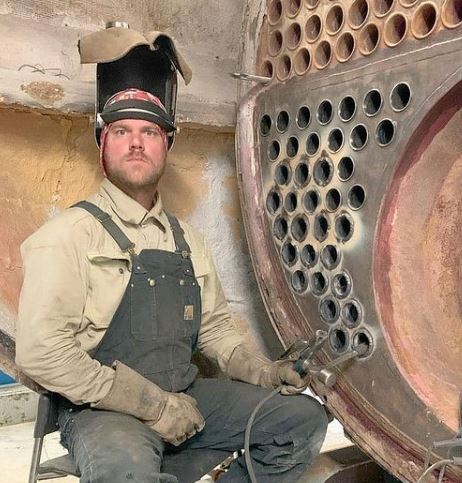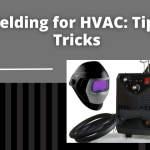Its high precision and ability to produce high-quality welds on thin materials. In the power generation industry, tig welding is often used to manufacture and repair equipment such as turbines, generators, and piping systems.
Advantages of tig welding for power generation applications include:
- The ability to produce clean.
- High-quality welds with minimal distortion.
- The ability to weld a wide range of materials.
- The ability to weld in all positions.
However, tig welding also has some disadvantages, including a slower welding speed than other methods and the need for a skilled operator.

Tig Welding for Power Generation
The materials and equipment used in tig welding for power generation applications vary depending on the project’s specific requirements. Common materials include stainless steel, aluminum, and carbon steel, while tig welding equipment includes the tig torch, filler rod, and shielding gas.
Preparing for Tig Welding in Power Generation
Proper preparation is essential for achieving high-quality tig welds in power generation applications. This includes selecting the right materials and equipment for the project, cleaning and fitting the materials, and setting up the welding station.
When selecting materials for tig welding in power generation, it is important to consider the application’s specific requirements. For example, stainless steel may be a good choice for its corrosion resistance, while aluminum may be preferred for its lightweight and corrosion-resistant properties.
It is also important to clean the materials thoroughly before beginning the welding process to remove any contaminants that could impact the quality of the weld. The materials should also be fitted and clamped together properly to ensure a consistent and strong weld.
To set up the welding station, it is important to ensure that the equipment is properly calibrated and that the workspace is well-ventilated and free of hazards.
Techniques for Power Generation
Tig welding requires a skilled operator to produce high-quality welds, and several techniques can be used to achieve the desired result. The technique chosen will depend on the materials being welded, the common type, and the position of the weld.
To produce a tig weld, the operator will use the tig torch to heat the base metal and the filler rod to add filler material to the weld. The shielding gas protects the weld pool from contaminants in the air.
One key factor in achieving high-quality tig welds in power generation applications is controlling the welding speed. Welding too fast can result in a porous or weak weld, while welding too slow can lead to excess heat input and distortion. It is also important to maintain proper arc length, which is the distance between the tungsten electrode and the weld pool.
Another important consideration is the choice of shielding gas. Different shielding gases can be used depending on the materials being welded and the application’s specific requirements. For example, argon is often used for stainless steel welding, while a mixture of argon and helium may be used for aluminum welding.
Quality Control and Safety Considerations
In the power generation industry, it is essential to maintain high levels of quality control to ensure the safety and reliability of equipment. Tig welding can impact the performance and safety of equipment if the welds are not properly executed, as faulty welds can lead to equipment failure and potential accidents.
To ensure the quality and safety of tig welds in power generation applications, it is important to implement several quality control measures. These can include visual inspection of the welds, non-destructive testing methods such as ultrasonic or radiographic testing, and thorough documentation of the welding process.
In addition to quality control, it is important to consider safety when tig welding in the power generation industry. Welding can produce several hazards, including the risk of burns, electric shock, and exposure to harmful fumes. It is important to use the appropriate personal protective equipment (PPE) and implement hazard control measures such as ventilation and fire prevention to protect workers.
Maintenance and Repair of Tig Welded Equipment
Proper maintenance and repair of tig welded equipment are essential to ensure the safety and efficiency of power generation operations. Regular inspections should be conducted to identify any issues with the equipment, and repairs should be made promptly to prevent equipment failure and downtime.
Common issues with tig welded equipment in power generation applications include corrosion, wear and tear, and fatigue. To prevent these issues, it is important to use the appropriate materials and techniques for the specific application and to properly maintain and repair the equipment as needed.
What Direction Do You, Tig Weld?
For horizontal welds, the welder generally moves the torch and filler metal in a back-and-forth motion, starting at one end of the joint and moving toward the other. For vertical welds, the welder generally moves the torch and filler metal in an up-and-down motion, starting at the bottom of the joint and moving toward the top. For overhead welds, the welder generally moves the torch and filler metal in a circular motion, starting at the center of the joint and working toward the edges.
The type of material being welded can also influence the direction of TIG welding. For example, certain materials may require a specific direction of welding to ensure proper penetration and fusion of the weld.
Does Tig Need Pulse?
Pulse TIG welding can be useful in certain situations because it allows the welder to control the heat input and the filler metal addition more precisely. It can also help to reduce the risk of overheating the material and causing distortion. However, pulse TIG welding requires more advanced equipment and may only be necessary for some welding applications.
How Far Should Tig Tip Stick Out?
The appropriate electrode extension will depend on the size of the tungsten electrode, the type of material being welded, and the thickness of the material. Generally, a longer electrode extension is typically used for thicker materials, while a shorter electrode extension is typically used for thinner materials.
What Is Tig Scraping?
TIG scraping is important because contaminants and defects on the material’s surface can negatively impact the quality of the weld. By removing these contaminants and defects before welding, the welder can ensure that the weld joint is clean and free of defects, improving the weld’s strength and appearance.
What Is Lift Tig Mode?
A high-frequency current is used in Lift TIG mode to create a plasma field around the tungsten electrode. When the welder is ready to start the arc, they can bring the tungsten electrode close to the workpiece, and the plasma field will initiate the arc without requiring physical contact. This can make it easier to start the arc and can help to reduce the risk of contaminant
Conclusion
In conclusion, tig welding is a popular and effective method for manufacturing and repairing power generation equipment due to its high precision and ability to produce strong and durable welds. To ensure the quality and safety of tig welded equipment in the power generation industry, it is important to implement quality control measures and follow proper safety protocols. Looking towards the future, it is likely that tig welding will continue to be a vital part of the power generation industry, with advancements in technology and techniques likely to further improve the efficiency and effectiveness of this welding method.

It’s been years since I got into welding as a side hustle. It’s been so long since Doing All kinds of welds for business and pleasure as this is my hobby. Being in this field I have learned from hands-on-experience also came to know what gears work and what doesn’t. The Tig Welder is my own platform where I use to share my experience.






Leave a Reply